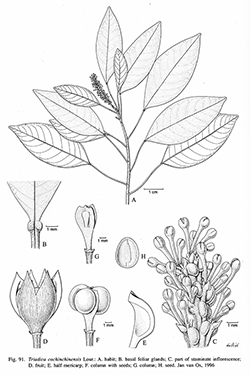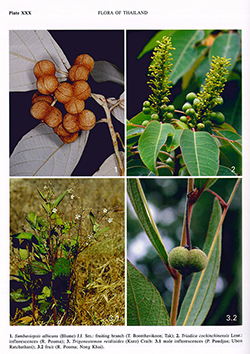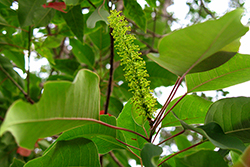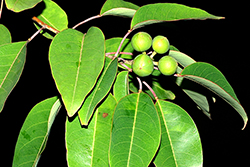e-Flora of Thailand
Volume 8 > Part 2 > Year 2007 > Page 573 > Euphorbiaceae > Triadica
Triadica cochinchinensis Lour.wfo-0000327065
Fl. Cochinch. ed. 1, 2: 610. 1790; ed. 2. 2: 749. 1793; Esser, Blumea 44: 201, fig. 7, map 7.— Sapium cochinchinense (Lour.) Pax & K.Hoffm. in Engl., Pflanzenr. IV. 147. v: 252. 1912.— Shirakia cochinchinensis (Lour.) Hurus., J. Fac. Sci. Univ. Tokyo, Sect. 3, Bot. 6: 318. 1954; Kruijt, Biblioth. Bot. 146: 93. 1996. Fig. 91; Plate XXX: 2.
Accepted Name : This is currently accepted.
Synonyms & Citations :
Description : Shrub to tree, up to 25 m high; deciduous with crown bare for 1–2 weeks. Stipules 0.3–2 by 0.6–0.7 mm. Leaves pinkish when young, withering blood red; petiole 1–3 cm long; blade slightly ovate to elliptic, (2.5–)3.5–7 by 1–3 cm, length/width ratio ca 2, base cuneate to attenuate (to obtuse), apex obtuse to acuminate, upper surface with a pair of basal glands, lower surface whitish-papillate to whitish-glaucous, with 0–3 glands per side, nerves in 9–17 pairs. Inflorescences: staminate part 25–50 by 7–10 mm. Staminate flowers: pedicel 2–3 mm long; calyx ca 1 mm long; stamens with filaments 0.75–1 mm long when flowering, anthers 0.4–0.5 mm long. Pistillate flowers 0–13 per thyrse; pedicel 2–4mm long; calyx 1–2 mm long, rarely with basimarginal glands; stigmata 2–3 mm long. Fruits globular, 7–9 by 7–9 mm, base often clavate, slightly or not sulcate, apex rounded. Seeds 3.5–5 by 3.5–4.5 by 2.5–3 mm.
Thailand : NORTHERN: Chiang Mai (Doi Inthanon, Pang Tong); NORTH-EASTERN: Nong Khai (Phu Wua WS); EASTERN: Nakhon Ratchasima (Khao Yai); PENINSULAR: Phangnga, Trang (Ko Chang).
Distribution : NE India, Burma, Indochina (type) up to Taiwan and E China, and W Malesia: Malay Peninsula (including Singapore), Sumatra, N Borneo (Sabah, Sarawak), the Philippines (Palawan), and Sulawesi.
Ecology : Primary forests, disturbed forests, young secondary forests of 5 years, and thickets, on hillsides and steep slopes, also in dry places, soil: yellow and granitic sand, fairly common, 10–1,000 m alt. Flowering and fruiting the whole year through.
Vernacular : Sali nok (สาลีนก)(Northern); ta khian thao (ตะเคียนเฒ่า)(Southeastern); pho nok (โพนก), som (ส้อม), ya chong (หญ้าจง), yuea chong (เหยื่อจง)(Peninsular).
Uses: ‘t Mannetje & Jones (1992) cite the species as a timber tree, additionally as a minor forage plant. The wood is soft, light and not of great use (Burkill, 1935). The seed coat contains less palmitic acid than that of Triadica sebifera, and is therefore not used.




